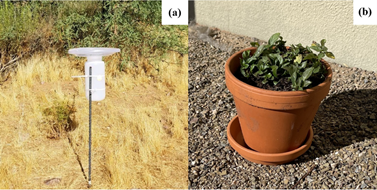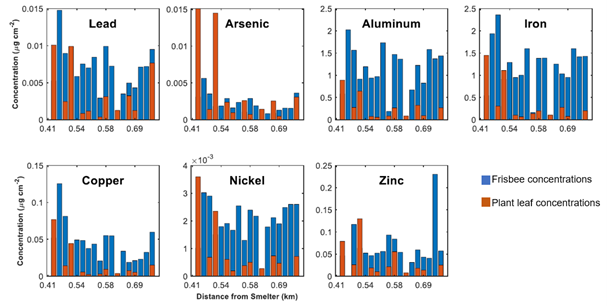Superfund Research Program
Helping Communities Monitor Air Pollution Using Plants
View Research Brief as PDF(541KB)
Release Date: 10/06/2021
![]() subscribe/listen via iTunes, download(5.2MB), Transcript(84KB)
subscribe/listen via iTunes, download(5.2MB), Transcript(84KB)
An NIEHS Superfund Research Program (SRP)-funded study revealed that certain plants can be used to effectively monitor metals and other pollutants in air. Community members collected environmental data used in the study as part of the Gardenroots project, which involves residents in research activities to evaluate human and environmental health effects near former and operating mining sites in Arizona. The study was led by University of Arizona SRP Center researcher Monica Ramirez-Andreotta, Ph.D.
Superior, Arizona, was home to copper, gold, and silver mines beginning in the mid-1800s. While the mines are no longer in operation, wind-blown dust from the sites is contaminated with metals, such as arsenic, cadmium, and lead. This dust can be harmful to nearby communities.
Plants have been used in environmental cleanup because they can be tailored to remove, contain, or detect chemicals in soil, water, sediments, or air. In this study, the team sought to:
- Evaluate if dust collected on plant leaves could serve as low-cost indicators of metals in airborne dust.
- Compare this method’s effectiveness to a standard monitoring device, an inverted plastic frisbee that collects dust on its surface.
Leveraging Citizen Science

The researchers trained 20 Superior residents on how to properly collect soil, water, and dust samples from their own backyards. Participants were given a peppermint plant, since other Gardenroots studies showed dust particles adhering to the surface of a mint leaf. They were instructed to keep the plant outside their house next to the frisbee sampler for a month. The citizen scientists collected the plant leaves in test tubes and placed the frisbee in a Ziploc bag to send to the lab for testing.
Samples were analyzed for arsenic, lead, iron, copper, aluminum, nickel, and zinc.
Overall, they observed that frisbees collected more dust than plant leaves. Iron and aluminum were the most abundant metals collected from both techniques.
Statistical calculations showed that both collection methods had similar average concentrations for all metals of interest. According to the authors, their results suggest that plant leaves may function similarly to the inverted frisbee for contaminant sampling.
They also evaluated the relationship between distance to a former metal smelting site and metal concentrations. As expected, they observed that metal concentrations in both the plant and frisbee collection methods decreased slightly as distance from the smelter increased. In study sites closer to the former smelter, plant samples had greater metal concentrations than samples from the frisbee collection method.

Using enrichment factor calculations, the team evaluated if metals detected in dust originated from nature or human activity and compared their results to those from similar mining sites. Enrichment factors from both collection methods were similar to those reported from other mining areas. They observed that lead and zinc had the highest enrichment factor values, indicating moderate to significant contamination.
Future Directions
According to the authors, their results show that citizen scientists, especially those living in remote sites or where sampling resources are limited, can use peppermint plant leaves as a low-cost way to monitor metals in air and dust.
Moving forward, the team hopes to evaluate other plants for effectiveness in a similar study. They also plan to sample dust more frequently to better account for environmental conditions, such as wind and rain, that would affect dust deposition.
For More Information Contact:
Monica Ramirez-Andreotta
University of Arizona
Saguaro Hall, 310
Tucson, Arizona 85721
Phone: 520-621-0091
Email: mdramire@email.arizona.edu
To learn more about this research, please refer to the following sources:
- Zeider K, Van Overmeiren N, Rine K, Sandhaus S, Saez AE, Sorooshian A, Munoz HC, Ramirez-Andreotta M. 2021. Foliar surfaces as dust and aerosol pollution monitors: An assessment by a mining site. Sci Total Environ 790:148164. doi:10.1016/j.scitotenv.2021.148164 PMID:34380246 PMCID:PMC8362843
To receive monthly mailings of the Research Briefs, send your email address to srpinfo@niehs.nih.gov.


